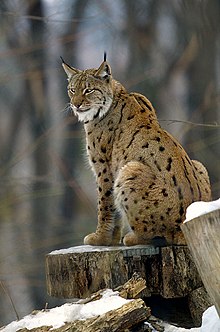Balkan Lynx
| Balkan lynx | |
|---|---|
 |
|
| Scientific classification | |
| Kingdom: | Animalia |
| Phylum: | Chordata |
| Class: | Mammalia |
| Order: | Carnivora |
| Family: | Felidae |
| Genus: | Lynx |
| Species: | L. lynx |
| Subspecies: | L. l. balcanicus |
| Trinomial name | |
|
Lynx lynx balcanicus Bures, 1941 |
|
| Synonyms | |
|
Lynx lynx martinoi |
|
Lynx lynx martinoi
(Miric, 1978)
The Balkan lynx (Lynx lynx balcanicus syn. Lynx lynx martinoi) is a subspecies of the Eurasian lynx in the Lynx genus. It is found in eastern Albania and western Macedonia, with smaller populations in Kosovo and Montenegro. It is considered a national symbol in the Republic of Macedonia and appears on the Macedonian five denar coin. It is believed that in Macedonia there are from 35 to 40 remaining Balkan lynx, mostly found in Mavrovo National Park. This cat is considered to be the largest cat in the Balkans. It has been sighted in 2011 and 2012 in the northern mountainous region of Albania and within the boundaries of the Shebenik-Jabllanice National Park. It is classified as Critically Endangered in Albania and has been protected de jure since 1969, but despite this illegal poaching and habitat destruction threatens the remaining Balkan lynx populations in both Albania and Macedonia. There are an estimated 15-20 individuals still alive in Albania. The Balkan lynx has been on the brink of extinction for nearly a century, with total numbers estimated to be fewer than 50. The Balkan lynxes' decrease in number have been thought to be due to illegal poaching. The Balkan lynx starts mating around January to February, and gives birth in April. While the Balkan lynx is listed as a subspecies in much of the news coverage and taxonomic references, there has been some dispute over those claims.
...
Wikipedia

